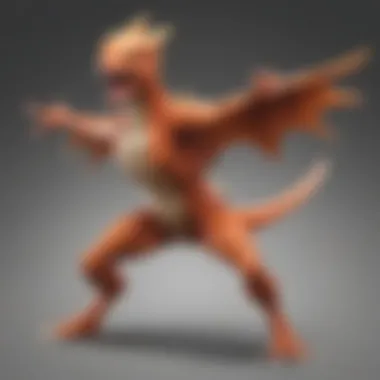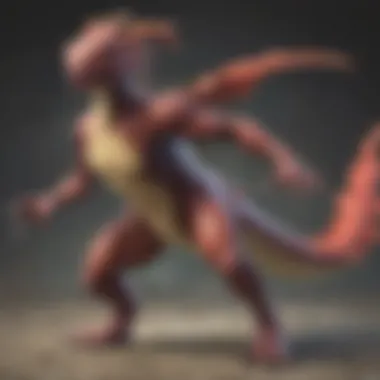Top Ten Moves in Pokémon: A Comprehensive Analysis


Intro
The Pokémon universe, built upon the principles of strategy, competition, and community, has captured the interest of players since its inception. The mechanics surrounding battling are central to this experience. Among the many elements that shape battles, moves hold significant importance. This article delves into the top ten moves, assessing their impact and utility across various game versions.
To understand why certain moves excel, we must first grasp the evolution of Pokémon gameplay. The series has developed mechanics that enhance tactical depth, influencing how players approach combat. From simple moves to complex strategies, each game variant introduces innovations, requiring users to adapt.
In exploring these moves, this analysis will benefit players seeking both foundational knowledge and advanced strategies. Novice trainers will find value in understanding basic concepts, while seasoned competitors will appreciate detailed assessments of each move’s contextual applications.
Pokémon Game Overview
History of Pokémon Games
Pokémon originated as a concept in 1996, spearheaded by Satoshi Tajiri. Initially, the game emphasized capturing creatures and battling them. Over time, numerous games, expansions, and spin-offs evolved, enriching the lore and gameplay. Today, Pokémon encompasses a diverse franchise featuring not only games but also animated series and trading cards.
Evolution of Gameplay Mechanics
The Pokémon series has undergone substantial growth regarding gameplay mechanics. Early games utilized turn-based combat with elemental strengths and weaknesses. Updates introduced new move types, abilities, and strategies, reflecting player preferences and trends in gaming. Moves are no longer standalone; their interactions with Pokémon types, abilities, and items are complex.
Preamble to Different Game Versions
The core titles, such as Pokémon Red, Blue, and more recent releases like Pokémon Sword and Shield, demonstrate the adaptability of the series. While basic principles remain consistent, each iteration introduces new Pokémon, moves, and mechanics. Such variations keep the game fresh while retaining its core conveyance of strategy.
Tips and Strategies
Beginner's Guide to Pokémon Games
For those new to Pokémon, understanding move types and their strategic uses is essential. Start with familiarizing yourself with elemental advantages; for example, Water moves are strong against Fire-type Pokémon. Additionally, grasp basic mechanics such as status effects can dramatically sway an encounter.
Advanced Gameplay Tactics
Experienced players should explore synergy among moves and Pokémon abilities. Moves like Stealth Rock and Spikes set the stage for strategic advantage. Incorporating these tactics can change the momentum of a battle. Consider moves that grant status effects or boost teammates’ performance, effectively enhancing team effectiveness.
Team Building Strategies
Building a well-rounded team requires balancing strengths and weaknesses. Consider a diverse set of moves to accommodate various opponents. A team with strong coverage will ensure flexibility in battles. In addition, regular updates and patches can shift the competitive landscape, so staying informed is crucial.
Character Spotlights
Featured Pokémon Profiles
Character choices in Pokémon significantly influence strategy. For instance, characters like Gardevoir with moves such as Psychic and Moonblast excel in specific contexts, while others like Gyarados can dominate due to their versatility. A deep understanding of a Pokémon's move set is key to maximizing its potential in battle.
Analysis of Popular Characters
Popular characters often embody unique traits that align with certain move types. Characters like Lucario, with moves that allow both offensive and defensive plays, show how the right moves can shape character roles. Players benefit from analyzing these profiles to refine their strategies.
Impact of Characters on Gameplay
The choice of Pokémon can dramatically affect battle outcomes. Each character's abilities and available moves create a web of interactions that can be exploited. Understanding these dynamics enhances the strategic elements within battles, allowing players to make informed decisions.
Latest News and Updates
Recent Game Releases
As the Pokémon franchise continues to innovate, newer titles frequently emerge. Games like Pokémon Legends: Arceus introduce alternative gameplay mechanics and fresh Pokémon, requiring players to adapt their strategies.
Patch Updates and Events
Regular updates can alter move effectiveness and character abilities. It’s important for players to remain updated and adjust their strategies accordingly. Events often introduce new challenges, providing opportunities to test newly developed strategies.
Rumors and Speculations
The Pokémon community is abuzz with speculation about upcoming releases and potential move changes. Engaging with forums, such as on Reddit, can offer insights into community discussions and potential strategies to consider before official announcements.
Remember, knowledge of the current meta and update changes will keep you competitive. Stay informed and be prepared to adapt your approach depending on the evolving gameplay landscape.


Prologue to Pokémon Moves
Understanding Pokémon moves is essential for mastering the game. Moves determine how Pokémon engage in combat. Each move has its own attributes such as type, damage, accuracy, and effects. These elements play a crucial role in shaping battle strategies. Players who grasp the intricacies of moves can gain significant advantages in both casual and competitive environments.
Understanding Move Categories
Pokémon moves fall into several categories based on their type and effects. They can be categorized as damaging moves, status moves, and healing moves.
- Damaging Moves: These moves deal direct damage to opponents and are often influenced by the Pokémon's stats. For instance, moves like Thunderbolt and Earthquake are effective choices for offensive strategies.
- Status Moves: These moves do not inflict direct damage. Instead, they can paralyze, put to sleep, or confuse the opponent. These effects can be game-changers in battles.
- Healing Moves: Moves like Roost allow Pokémon to recover health, adding a layer of sustainability to a team’s strategy.
Understanding these categories allows players to choose moves that complement their team and tactics, aligning with their overall gameplay approach.
The Importance of Strategy in Moves
Selecting the right moves is not merely about effectiveness; it involves strategic foresight. Each move must fit into a larger plan for team synergy and countering opponents.
- Types and Counters: Moves can interact in a counteractive manner. For instance, using Water-type moves against Fire-types can secure strong advantages.
- Energy and Turn Management: Moves require careful energy management. Some powerful moves, like Hyper Beam, may require a recharge turn, creating a window of vulnerability.
- Adaptability: In battles, adaptability is critical. Players need to adjust their strategies based on the opponent's team composition and current situation.
Ultimately, the ability to formulate a tactical approach while selecting moves can lead to success in Pokémon battles, making this understanding a vital part of gameplay.
Evaluating the Top Ten Moves
Evaluating the top moves in Pokémon is crucial for understanding the game at a deeper level. Each move can dramatically influence the outcome of battles. By analyzing these moves, players can refine their strategies and enhance their overall gameplay experience. This section examines why some moves have gained prominence over others and what factors contribute to their success.
In this analysis, we will explore two main elements that are significant in evaluating these moves: criteria for selection and the impact of move types. Understanding these aspects not only aids in selecting the right moves for battles but also prepares players to adapt to various challenges they may face in different scenarios.
Criteria for Selection
Selecting the top moves involves a careful assessment of various factors. Here are the key criteria that contribute to this selection process:
- Damage Output: The potential damage a move can inflict is a primary consideration. Moves that can deal significant damage often take precedence in competitive play.
- Accuracy: A move's ability to hit the target consistently is vital. High accuracy ensures that a player can rely on a move during critical moments.
- Energy Cost: It is important to analyze how much energy a move requires. Moves that balance high damage with low energy cost offer better efficiency in intense battles.
- Status Effects: Secondary effects of moves, such as causing paralysis or sleep, can alter the dynamics of a match. Moves that provide strategic advantages beyond just damage output tend to have higher value.
- Versatility: Moves that can be useful in a variety of situations are essential. Their ability to target different Pokémon type increases their practicality in team compositions.
Examining these criteria allows players to make informed decisions about which moves to integrate into their strategies, enhancing their chances of victory.
Impact of Move Types
The type of a Pokémon move plays a significant role in determining its effectiveness. Each type has its unique strengths and weaknesses, which makes understanding them essential for strategic play. Here are some key aspects related to move types:
- Type Matchups: Moves that exploit type weaknesses can turn the tide of battle. For example, a Water-type move against a Fire-type opponent is disproportionately effective.
- Synergy with Team Composition: Considering the overall team strategy when selecting move types is important. Having a diverse range of types can counter opponents effectively.
- Meta Considerations: The current competitive environment often dictates which types are favorable. As the meta changes, the effectiveness of certain move types may correspondingly fluctuate.
In brief, the assessment of move types is paramount for success in Pokémon battles. By understanding these concepts, players can elevate their gameplay and adapt their strategies accordingly.
Detailed Analysis of Top Moves
This section focuses on the significance of the top moves in Pokémon and their contributions to gameplay. Understanding the detailed mechanics of these moves is crucial for both casual and competitive players. Each move serves a specific strategic purpose and can dramatically affect the outcome of battles. By analyzing these moves in depth, players gain insights that enable them to optimize their strategies and improve performance.
Move One: Hyper Beam
Damage and Energy Considerations
Hyper Beam is known for its substantial damage output. This attribute makes it a valuable option in many scenarios. With a high base power, it can knock out weaker opponents in a single hit. However, the energy cost is significant; thus, players must consider whether the alteranative move might be more effective in a long-drawn match. This move’s unique feature is the recharge time that occurs after using it, which can leave the user vulnerable. It is essential to balance its power against the potential risks, especially when facing faster opponents.
Usage in Competitive Play
In competitive settings, Hyper Beam stands as a double-edged sword. Its high damage makes it an enticing choice, especially when opponents might underestimate it. Yet, the recharge phase can be exploited by enemies, allowing them to retaliate effectively. Players often choose to use it as a surprise tactic. Here, the move’s unique characteristic is its ability to finish off weakened foes. Nonetheless, in matches where opponents anticipate this attack, its utility is greatly diminished.
Move Two: Dragon Dance
Role in Boosting Statistics
Dragon Dance is a powerful move that boosts the user's Attack and Speed. This buffing characteristic is what makes it an essential move to consider. By strengthening a Pokémon's capabilities, players can turn the tides of battle when used wisely. The move is particularly beneficial for sweepers. It allows them to outspeed and knock out multiple foes in a single turn.
Advantages in Long-Term Strategy
Dragon Dance has noteworthy advantages for long-term combat. By setting up, Pokémon can build momentum for subsequent turns. This move facilitates strategies that rely on gradual power increase. As a result, it is often used in setups to maintain pressure against opponents. The unique aspect is its ability to make Pokémon formidable threats after just one or two uses. Yet, the downside remains: if the user is defeated during the setup, the effort becomes moot.
Move Three: Earthquake


Area of Effect
Earthquake’s area of effect is one of its strongest assets. It deals damage to all adjacent foes, making it an excellent choice in double battles or when targeting groups. This characteristic can turn the battle in the user’s favor by damaging multiple opponents at once. Its unique feature is the ability to hit hard while being relatively low-cost in terms of energy.
Competitive Viability
In competitive play, Earthquake maintains high viability due to its power and area coverage. Many ground-types have access to this move, further cementing its role in various teams. This usage characteristic allows players to deal with multiple threats efficiently. However, the potential to hit allies in doubles can be a downfall, necessitating careful coordination among teammates.
Move Four: Thunderbolt
Type Advantage
Thunderbolt offers a clear type advantage against several common Pokémon. This ability makes it a popular choice, especially against water and flying types. Its damage output combined with the potential to paralyze the opponent increases its overall effectiveness. The move's unique aspect lies in its dual capability to inflict damage while potentially incapacitating the target.
Utility in Various Matches
In many battles, Thunderbolt proves useful across a range of matchups. Its versatile nature allows it to function effectively in both casual and competitive settings. When used against a team weak to electric attacks, it can become a game changer. However, its dependability can vary based on type matchups, underscoring the importance of strategy.
Move Five: Protect
Strategic Defense
Protect is a defensive move that allows Pokémon to guard against incoming attacks. This characteristic adds substantial strategic depth to gameplay. Players often employ Protect to delay damage while setting up for future moves. The unique feature is its ability to block not only physical damage but also various status effects, providing a tactical edge.
Synergy with Other Moves
Protect’s synergy with other moves enhances its overall effectiveness. By creating openings, players can use it alongside setup moves like Dragon Dance or Swords Dance. Consequently, this strategic combination can create devastating chances for counter-attacks. However, its limited usage can force players to think creatively about when to deploy it or risk being ineffective.
Move Six: Flamethrower
Damage Output vs. Energy Cost
Flamethrower is prized for its balance of damage and energy cost. It provides significant fire-type damage while remaining efficient to use. This characteristic makes it appealing among various fire-type moves. The move’s unique aspect is the chance to cause burn, adding secondary effects to its attack.
Situational Usage
In battles, Flamethrower is particularly effective in situations where fire-type advantages can be leveraged. Its situational usage makes it a go-to for many teams, especially against grass and ice types. Players must, however, be wary of using it against water-type opponents, which can neutralize its effectiveness.
Move Seven: Swords Dance
Buffing Mechanics
Swords Dance is a quintessential move for buffing attack strength. The mechanics allow Pokémon to boost their Attack stat significantly. This characteristic can set up significant damage potential for the following turns. Players value this move because it can turn underpowered Pokémon into immediate threats.
Best Applications
Swords Dance shines in applications where damage needs to be amplified quickly. It serves well in scenarios where outpacing foes is paramount. Pokémon that can utilize Swords Dance effectively, coupled with high damage moves, can pose as major threats. However, the requisite waiting period to execute other moves afterward can be a drawback.
Move Eight: Roost
Healing Strategies
Roost facilitates healing for Pokémon, a critical part of survival in battles. This healing strategy allows players to regain health while maintaining offensive presence. Roost’s unique characteristic is the capability to restore half of the user’s Max HP, making it vital for stall tactics in prolonged battles.
Balancing Offensive and Defensive Play
Roost aids in balancing strategies between offense and defense. This characteristic allows players to withstand more damage while maintaining offensive pressure. However, if overused, it can relinquish valuable attacking opportunities that can define a match, requiring careful timing.
Move Nine: Ice Beam
Secondary Effects
Ice Beam is noted for its capacity to freeze opponents, a critical secondary effect. This characteristic makes it more than just a damage move; it can disrupt opponent strategies. The unique feature is the additional status infliction, which can lead to critical moments in battle.
Critical Match-ups
Ice Beam is particularly effective in match-ups against dragon-types and ground-types. In many situations, having this move provides a strategic advantage when facing expected threats. However, players should always consider the risk of encountering Pokémon that resist ice-type moves, limiting its effectiveness.


Move Ten: Stealth Rock
Setting Up for Team Advantage
Stealth Rock serves as a foundational move for team strategy. It sets hazards that impact opponents upon entry. This unique characteristic allows players to plan against specific team compositions, providing a significant long-term advantage.
Long-term Implications in Battle
The long-term implications of Stealth Rock can define the pacing of a match. Teams that can effectively use hazards have an edge over opponents, applying consistent pressure. However, players must remember that effective counter-play by opponents can nullify this effort, highlighting the importance of timing and team synergy.
Strategic Placement of Moves in Team Composition
In the competitive realm of Pokémon, the placement of moves within a team composition is critical for achieving success. Players must consider not only the individual strengths of each move but also how these moves fit into the larger strategy of the team. A well-structured team utilizes each Pokémon's unique capabilities, while also ensuring that the overall team remains versatile and resilient against a variety of opponents.
The importance of this strategic placement cannot be overstated. Moves must complement each other and work synergistically. This ensures that players can adapt to different battle situations and opponents, maximizing their chances of winning. By understanding the roles of different moves and how they impact team dynamics, players can craft teams that function effectively in various gameplay scenarios.
Building a Balanced Team
To create a balanced team, trainers need to evaluate both offensive and defensive capabilities. A balanced team typically includes Pokémon that cover a range of types and moves to counter the diverse threats they may face.
Key aspects to consider while building a balanced team include:
- Type Diversity: Use Pokémon of various types to mitigate the weaknesses inherent in any single type. For example, a team with Water, Fire, Grass, and Electric types can better handle opposing threats.
- Role Specification: Assign specific roles to Pokémon such as physical attacker, special attacker, tank, or support. This helps in maintaining focus and direction during battles, allowing trainers to leverage the strengths of each Pokémon efficiently.
- Move Compatibility: Choose moves that align with the Pokémon's strengths and the team's overall strategy. Selecting moves that provide coverage against common threats or bolster each Pokémon's effectiveness ensures a well-rounded approach.
A balanced team can navigate the intricacies of competitive battles more effectively, allowing trainers to respond to different challenges that may arise during gameplay.
Complementary Move Choices
Choosing moves that complement one another is vital to enhancing team synergy. Moves can fulfill specific roles that support or empower teammates.
Several considerations should guide the choice of complementary moves:
- Type Coverage: Selecting moves that cover the weaknesses of other team members can provide a strategic advantage. For instance, if a team has a Fighting-type Pokémon, pairing it with Psychic or Flying type moves can cover its resistance to Fairy-type moves.
- Status Moves: Incorporating status moves can dramatically shift the tide of battle. Moves like "Thunder Wave" or "Will-O-Wisp" can cripple opponents, making them easier targets for subsequent attacks.
- Synergy with Abilities: Each Pokémon’s ability can influence move choice. For example, using "Rain Dance" alongside a Pokémon with the ability "Swift Swim" could increase speed dramatically while enabling Water-type moves to deal increased damage.
The integration of complementary moves serves not only to strengthen a team's overall performance but also to keep opponents guessing and off-balance.
Gameplay Scenarios Utilizing Top Moves
Understanding how the top Pokémon moves function in various gameplay scenarios is crucial for players at all levels. Moves are not used in isolation; their effectiveness often depends on the context in which they are applied. This section aims to dissect various gameplay scenarios, highlighting specific elements and considerations that players must account for. By grasping these scenarios, users can enhance their strategic mindset and utilize moves to the fullest potential.
Battle Strategies in Competitive Settings
In competitive play, the stakes are high, and the correct use of moves can shift the tide of battle. Players need to carefully evaluate each Pokémon's move set according to the opposing team's composition.
- Predicting Opponent's Moves: Anticipation is critical. If you expect an opponent to use a defensive move, preparing an attack that counters it effectively can yield significant advantages.
- Timing and Placement: Using moves like Protect at the right moment can allow your Pokémon to survive crucial hits while setting up for a counterattack or to heal. Recognizing when to deploy such strategies is essential for success.
- Synergy Between Moves: Some moves work exceptionally well together. For instance, using Stealth Rock to set hazards can be combined with a powerful attacker that benefits from the resulting damage on incoming enemies.
In summary, competitive settings demand a deep understanding of how each move can interact with both your strategy and that of your opponent.
Casual Play: Understanding Effectiveness
Casual play often involves a more relaxed setting, but understanding the effectiveness of moves still remains essential. Players can experiment with different strategies without the intense pressure of competition, leading to valuable insights.
- Experimentation with Moves: Since victory is not paramount, casual battles provide the perfect opportunity to test how well certain moves work together. For example, using Roost can give you a clear understanding of healing in conjunction with offensive moves.
- Learning from Defeats: Often, the most significant lessons come from losses. Analyzing why certain moves failed in a battle can provide insights that improve your future gameplay.
- Fun with Creativity: Casual settings allow players to get creative with their move choices. This freedom can lead to unexpected synergies and strategies that might not be apparent in competitive play.
“Casual gameplay offers a unique space for exploration and creativity, allowing trainers to devise unconventional strategies without high stakes.”
Understanding how to utilize moves effectively, whether in competitive matches or casual play, will enrich the overall Pokémon experience for fans of any age.
Epilogue and Future Considerations
In every competitive environment, understanding the nuances of strategies is vital. This applies to the world of Pokémon, where moves serve as crucial elements for success. The conclusion of this article emphasizes the necessity of adapting strategies based on evolving metas in gameplay. The effectiveness of moves can change as new Pokémon are introduced, and current ones receive balance updates. Therefore, remaining aware of these alterations is essential for maintaining an advantageous position in battles.
Adapting to Meta Changes
The nature of Pokémon battles is dynamic. Each generation introduces new elements, including types, abilities, and moves. Current meta shifts require players to rethink which moves remain viable and which may lose significance. For example, as certain Pokémon gain popularity, counters become necessary. Moves that may have been considered optimal in past seasons may become less effective or even detrimental as the competitive landscape evolves.
Players are encouraged to regularly review tier lists and strategies from reliable sources, such as Reddit, where communities share insights on adjusting to these changes. Knowledge and observation become key in determining when to pivot in strategy.
Final Thoughts on Move Selection
Selecting the right moves for your Pokémon team can often be a deciding factor in battles. As highlighted throughout the article, each move carries unique attributes that can influence outcomes. These considerations include types, power, secondary effects, and potential synergies with other moves.
Ultimately, a diverse move set allows for greater adaptability in different situations. This flexibility can create openings against opponents and capitalize on their weaknesses. Consider combining moves that either complement or contrast with your core strategy. For example, offensive moves should be balanced with defensive options to allow room for recovery.







